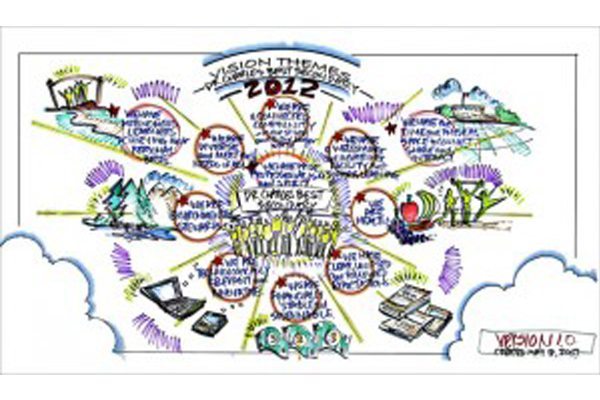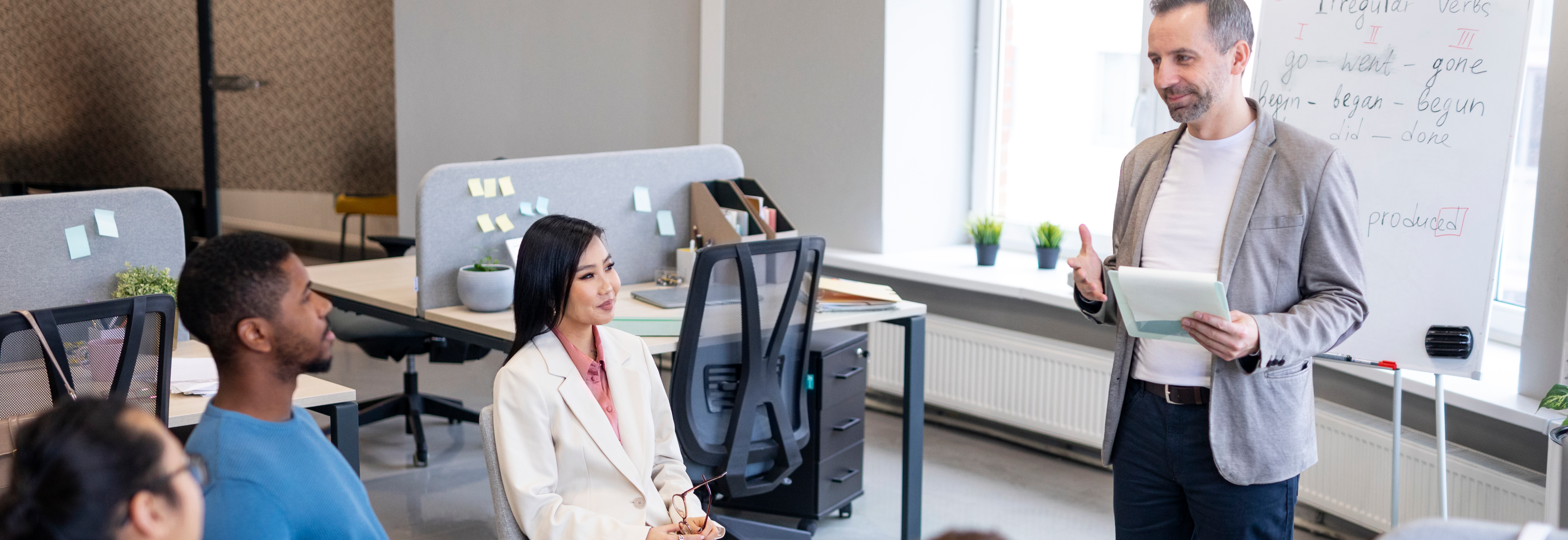Large group meetings — they’re often necessary, occasionally dreaded, and frequently mismanaged.
Whether it’s a business strategy meeting, a townhall, or a cross-functional collaboration session, pulling together a large group of individuals and ensuring a productive meeting is no small feat. In our experience facilitating such sessions across industries, we’ve noticed that efficient team meetings at scale require not just planning, but the right mindset, tools, and facilitation techniques.
Related Read: 5 Steps to More Effective Team Meetings
Let’s begin by asking: what qualifies as a “large group”?
Generally, any group larger than 30 participants brings with it the unique dynamics of scale — multiple perspectives, louder voices, passive listeners, and competing priorities. And while small group meetings have their own complexities, the challenges in larger settings tend to get amplified.
When designed and facilitated well, large meetings can be deeply impactful — unifying a group toward common goals, generating breakthrough ideas, and fostering alignment. But without structure, they can quickly spiral into chaos or disengagement.
In this post, we share 5 proven strategies (and a few bonus tips!) to facilitate effective large group meetings — drawn from our team’s extensive experience as facilitators, trainers, and learning designers.

1) Start with Clarity: Align with the Leader’s Intent
Table of Contents
One of the best meeting facilitation tips we’ve learned over the years is to begin by understanding the true “why” behind the meeting. This means sitting down with the meeting owner — usually a leader or decision-maker — well in advance of the session.
We often find that the person coordinating logistics may have a slightly different understanding of the goal than the person who is sponsoring the meeting. Misalignment here can derail outcomes and leave participants confused about the purpose.
Ask questions like:
- What change do you want to see after this meeting?
- What do you want participants to feel, know, and do by the end?
- Are there sensitive or non-negotiable topics?
Once clarity is achieved, use it to anchor all other decisions — agenda design, activity selection, facilitation approach, and tone setting. In business strategy facilitation, this alignment is even more critical — especially when senior leaders are involved.
2) Clarify the Goal, Timeline & Expectations Upfront
Never assume that everyone in the room knows why they are there. Even if the invite had a clear agenda, people may have missed it — or interpreted it differently.
In our workshops, we always start by:
- Restating the goal of the meeting clearly
- Outlining how much time is available
- Highlighting what’s in and out of scope
This brings the group together around a shared purpose and sets expectations for the day. It’s also a good time to introduce any facilitation meeting agenda templates or visual aids that might help participants track progress.
In fact, just one simple slide stating:
“Today, we are here to . We have to get there, and here’s how we’ll do it.”
— can instantly bring focus to the room.
3) Design a Structured Process with Milestones
A common pitfall in large meetings is an unclear or overly complex process. Participants might understand the big picture, but without a roadmap, they may feel lost or unsure how their contributions matter.
That’s where agile meeting facilitation techniques come in.
We recommend designing meetings using a clear framework that breaks the time into chunks — each with a clear goal. For example:
- Part 1: Understanding the problem
- Part 2: Generating ideas
- Part 3: Prioritizing solutions
- Part 4: Aligning on next steps
This approach, especially in business strategy sessions, ensures that energy and attention are focused and cumulative.
Don’t forget to include buffer time and flexibility — real-time adjustments may be required depending on group dynamics.
4) Facilitate with Structure (and Flexibility)
In large group settings, the role of the facilitator becomes even more critical.
In our experience, facilitator leadership is less about being an expert and more about being a guide who can:
- Keep the group focused and energized
- Balance participation across personalities
- Intervene when things go off track
One effective method we use is “tight facilitation” — which means setting time-boxed discussions, using signals like bells or timers, and rotating group roles (e.g., timekeeper, scribe). A facilitator for meeting in a large setup must be both assertive and adaptable.
At the same time, don’t be overly rigid. If the energy in the room is positive and aligned, allow flexibility for deeper discussion. The key is to not let one group or voice dominate.
We’ve also found success using facilitation in electronic meetings — through tools like Miro, Slido, or Jamboard — especially for hybrid or remote sessions. They help democratize input and ensure all voices are heard.
Related Read: 3 Attitudes for a Facilitator
Related Read: Facilitating with Excellence
5) Prioritize Breaks and Breathers
We cannot stress this enough: Breaks are not optional.
We often see meeting owners trying to “optimize” time by cutting breaks. However, skipping recovery time leads to fatigue, reduced participation, and — eventually — disengagement.
In our experience, for every 90 minutes of work, a 15-minute break is ideal. For lunch breaks, 60 minutes is the sweet spot for groups larger than 50. This not only ensures efficient meetings, but also helps participants socialize, reflect, and return recharged.
If you’re dealing with intense content — especially in effective leadership team meetings — consider structured breathing or mindfulness breaks as well. These small additions go a long way in maintaining energy and attention.
Additional Considerations
-
Use a Co-Facilitator or Moderator
For groups over 40, having a second facilitator or moderator can help keep track of logistics, field questions, or manage tech tools.
-
Plan for Multiple Formats
Combine breakouts, plenary sessions, and small group activities. This breaks monotony and gives participants different ways to engage.
-
Use Pre-Work and Follow-Ups
Pre-meeting surveys, data collection, or short reflection assignments can help kick-start meaningful discussions. Similarly, post-meeting follow-ups, summaries, or action plans help translate insights into execution.
-
Choose the Right Venue
Space matters. Ensure the venue supports audio-visual needs, group movement, and easy collaboration. For offsites, think beyond hotel boardrooms — creative spaces often spark more engagement.
Key Takeaways for L&D Professionals
As L&D professionals, facilitation in the workplace training is one of the most powerful tools at your disposal. Knowing how to run efficient team meetings or facilitate strategic planning retreats is not just about saving time — it’s about driving outcomes.
Here are a few things we’ve learned over the years:
-
Mindset shift is key:
Treat every large meeting as an opportunity for co-creation and shared learning.
-
Train the facilitators:
Whether internal or external, facilitator leadership training is worth investing in.
-
Adapt to your culture:
Not all organizations respond the same way. Customize your process to fit your context.
-
Measure impact:
Use tools like feedback forms, learning logs, or even performance metrics to understand the ROI of well-run meetings.
Want to explore more?
If you’re thinking of planning a leadership offsite, corporate retreat, or an important business strategy session — here are some related resources that might interest you:
- How To Plan a Productive Offsite
- What Not To Do In A Team Offsite
- 4 Things Employees Expect At An Offsite
- 20 Themes For Your Next Corporate Event
Let’s continue designing meetings that aren’t just efficient — but inspiring, inclusive, and impactful.









